United States by World Oil staff; Canada by Robert Curran, Calgary; Mexico by Sergio M. Galina Hidalgo, Mexico City
US DRILLING
Drillers gone wild
This midyear course correction gives us a chance to hedge the predictions we made at the beginning of the year. There have been times when we wished we would have stayed with the earlier forecast. To say that prices have been volatile is an extreme understatement. Five percent price swings in a day are now common, and 10% in a week has happened too. Since the data from this midyear correction was gathered during the extreme highs in oil and gas prices during June and early July ($145 and $13, respectively), we tend to think that the large percentage increases that are predicted for the second half by independents and majors (33% and 17%, see tables) are enthusiasm-based. So, we’ve tempered their zeal.
Although there is more revenue being generated by oil for the first time in many years, Baker Hughes still puts drilling at 4-to-1, gas-to-oil. The frenzy mostly lies in the new shale gas plays, which seem to be proliferating at one new play every few months. We’ve heard of lease prices of $2,500 an acre for untested plays. But, are there enough rigs to allow these increases? Well, it depends. If you want a high-spec, high-horsepower rig, the answer is “no”-you’ll have to wait for a newbuild. But, if you want a low-horsepower, old rig, there are several that are stacked and could be refurbished (see page 67). However, other infrastructure items, such as qualified rig hands or tubular goods, can easily slow down a well-made plan.
Also, the average well is deepening slightly over time, from 5,192 ft in 2003 to 5,589 ft in 2005 to 5,953 ft in midyear 2008. Much of this increase is in measured depth, since the number of horizontal wells has now exceeded the number of directionally drilled wells, while the number of all deviated wells (directional + horizontal) is now half of all wells drilled. So, on balance, it’s still possible for some managed growth, as this revised forecast indicates.
| Midyear revision, 2008 US drilling forecast |
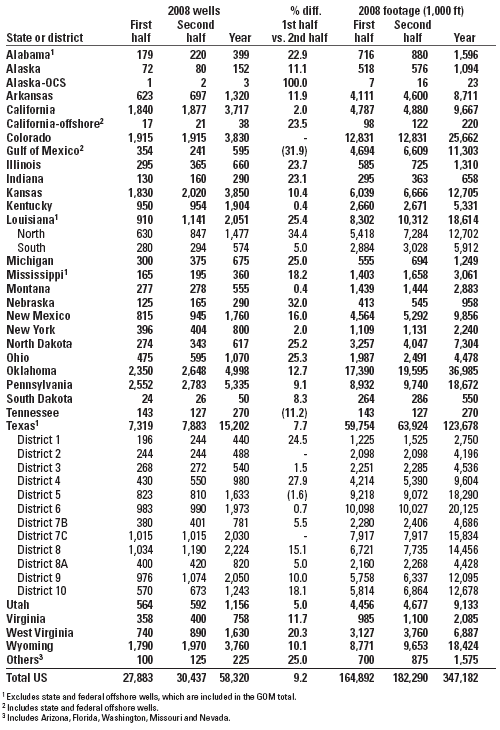 |
|
Operator surveys. For this update, World Oil surveyed 17 major operators (integrated oil companies and independents with large drilling programs) and 106 smaller independents for information about their remaining 2008 drilling plans. Our February estimation may have not been optimistic enough, as most states have increased the number of wells planned for 2008 since then, with only seven areas reporting significantly smaller numbers.
In 2008, drilling in the US will rise to slightly over 58,000 wells, some 5,900 more than predicted in our February forecast. Only Alabama, the Gulf of Mexico, Mississippi, Montana, New Mexico, Tennessee and Utah experienced significant downward revisions, the largest difference occurring in New Mexico with 433 wells less than predicted. The GOM follows with 191 fewer wells, some of which is due to reporting problems in defining the border between state and inland water wells. Offshore California, Ohio and South Dakota all have minor downward revisions.
Almost all states will see an increase in wells drilled from our February forecast. States reporting notable increases from revisions are California (1,201 extra wells), Oklahoma (902), Kansas (880), Wyoming (565), Kentucky (496), Pennsylvania (485), Arkansas (383) and northern Louisiana (353). As a note, the surveys supporting this forecast are not scientifically collected; however, the responses gathered represent a large majority of major operator’s plans.
| What 17 US major operators1 plan for 2008-Midyear update |
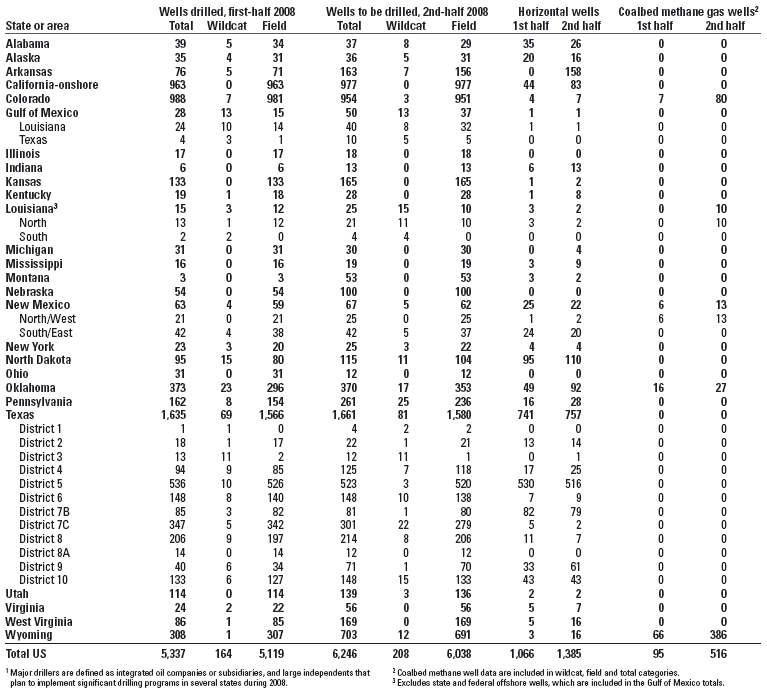 |
|
Rigs. The notable increase of wells drilled in almost every state would logically lead to higher rig counts. According to Baker Hughes, US rig counts have been steadily increasing since the beginning of 2008. In January, the count was hovering around 1,750 rigs, and in the middle of July the count reached 1,928, an 8.5% increase over the July 2007 count of 1,777.
Differences are often observed between rig-counting services like Baker Hughes and Smith International due to different methodologies. When an area has undergone an intense increase in drilling activity, reporting agencies may fall behind in collecting data. Well-count data trends may be opposite from rig count trends-this is due to services not counting small rigs.
With high dayrates, rigs are moving toward the most profitable areas, as they did last year. Some parts of the country, especially around the Appalachian Mountains, are experiencing ramp-ups in horizontal drilling opportunities, but are hindered from new activity by too few rigs in the area.
Prices. Henry Hub has been hovering around $11-$13/MMbtu for the past several months, and has been decreasing as of late. Oil has also taken a small, but quite notable, tumble, from its extreme highs and according to the Energy Information Agency’s Natural Gas Weekly Update, gas prices in mid-July are reflecting the oil fall. Gas prices will probably also be influenced by low LNG imports and an increasing storage deficit, despite production growth. Gas storage as of July 11 was 2.1% below the five-year average level for the report week, and was 361 Bcf below storage levels of July 2007.
The WTI reached $145.16/bbl on July 14, 2008, but experienced a $16.28 fall to $128.88/bbl on July 18. In July 2007, the WTI was around $74/bbl. The EIA projects that oil will average $127/bbl in 2008 and $133/bbl in 2009, and that gas (Henry Hub) will average $11.86/Mcf in 2008 and $11.62/Mcf in 2009.
Area highlights. Drilling appears to be segregated into conventional and unconventional drilling, as reported last year. Unconventional shale gas plays have experienced an upswing, and CBM has followed a decreasing trend in wells drilled that began in 2007. Rig count maps show clusters around Texas, Louisiana, Oklahoma, Arkansas, North Dakota and in Appalachia that are indicative of shale plays in those areas.
| What 106 US independents1 plan for 2008-Midyear update |
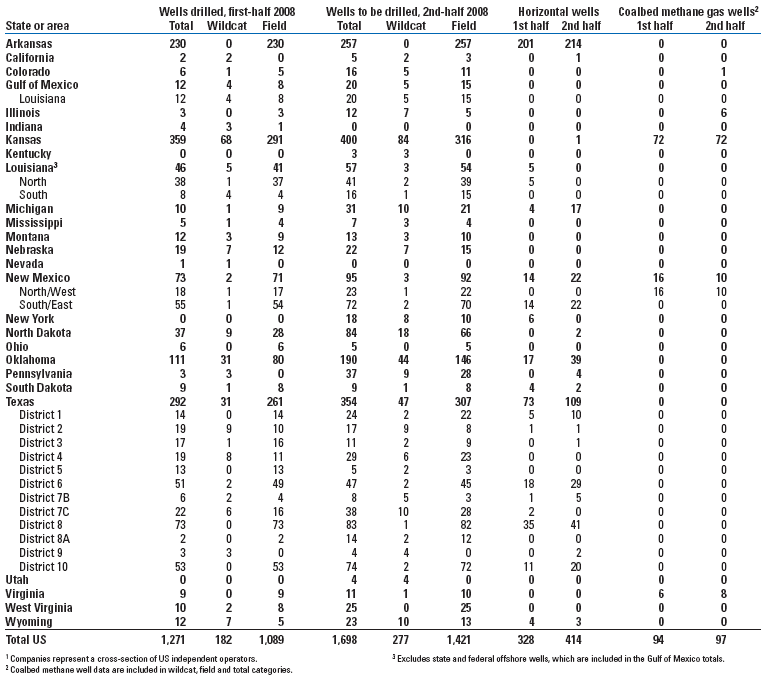 |
|
| What 9 Canadian drillers plan for 2008-Midyear update1 |
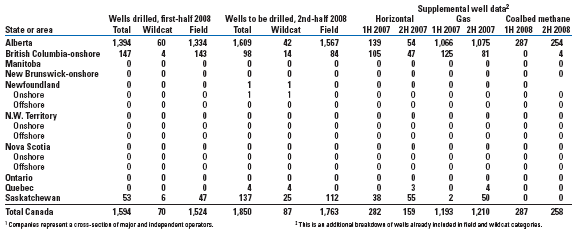 |
|
| Canadian drilling, 2008 provincial forecasts-Midyear update1 |
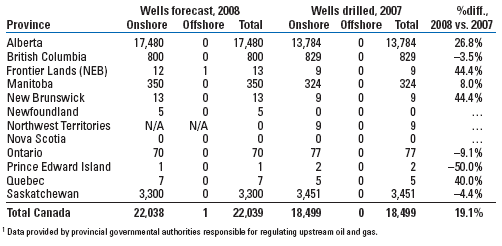 |
|
In Texas, the Barnett Shale continues to fuel drilling activity in Districts 5, 7B and 9, although Districts 7C and 10 saw the highest increase in the forecast revision. The Texas PetroIndex, provided by economist Karr Ingham and the Texas Alliance of Energy Producers, reached 271.4 in June (17.8% higher than in June 2007), that was a record high and the 64th consecutive monthly increase. The index is calculated using prices, rig counts, drilling permits, completion, production and employment numbers, among others, and essentially tracks the “health” of the E&P industry in Texas. We agree with the PetroIndex, and forecast over 15,000 wells to be drilled in Texas in 2008. The Texas Railroad Commission reports that permits to drill new wells in Texas are up about 470 from last year (2,444 in June 2008 and 1,974 in June 2007), and that there were 148 more wells drilled in June 2008 than June 2007.
The Haynesville Shale play is very hot, and may be the reason for the boost in drilling activity in northern Louisiana. The Haynesville, situated on the Louisiana/Texas border near Shreveport, but to a greater extent in Louisiana, has garnered attention after several companies released positive gas flowrates in March. City officials from Shreveport have talked with those from Fort Worth, hoping that the Haynesville has the potential to see Barnett-like success.
Reporting delays are common across the US, as rig activity outstrips the ability of the industry and state agencies to keep up with the information flow. In some states, like Tennessee there are other problems. Operators in that state have convinced the legislature to change the law, delaying well reporting for a full year, once the well is producing. In addition, duties for reporting and bonding have been moved to a different agency, so useful statistics will be harder to gather.
Pennsylvania will have almost 1,000 more wells drilled in 2008 than in 2007, and is second only to Texas in total number of wells drilled. This activity is partly related to the Marcellus Shale play, which runs across several Appalachian states; however, lack of horizontal-capable rigs in the northeastern US may hamper activity somewhat. Rigs will probably be moving in to meet demand, with even the Pennsylvania state forestry service contemplating leasing its land in an effort to see a Marcellus payoff. Pipeline infrastructure and water permits are other barriers that players in Pennsylvania face.
The flurry surrounding the Bakken of North Dakota has given that state a boost: We now forecast 617 wells drilled as opposed to the 414 drilled in 2007, although pipeline infrastructure space constraints will be a problem for North Dakota. However, legislators there are looking at building a new refinery to process Bakken crude that will combat transportation problems and provide local gasoline and diesel to the North Dakota market.
Rig crews are becoming very efficient, according to Mark Bohrer of the North Dakota Department of Natural Resources. He noted that a 13,900-ft well was recently drilled in 19 days. In some areas, the standard 1,280-acre spacing is being halved to 640 acres and the wells are getting longer, up to 20,000-ft MD. Most of this length is horizontal and the holes require staged fracing to open the shale.
Shale plays continue to support drilling in the Woodford of Oklahoma and the Fayetteville of Arkansas, with 1,365 more wells forecasted to be drilled in Oklahoma than actual wells drilled in 2007. Growth continues in California, which will have about 1,200 more onshore wells than forecasted in February, and where permits to drill new wells are up 23% from 2007. The Wall Street Journal reports that 43% of Californians support offshore drilling, and though legislators continue to oppose any offshore activity, anxiety over gas prices may push state residents to vote in favor of drilling in upcoming years. Environmental groups continue to block new drilling in Colorado, which will not see any major increase in activity this year, only up about 280 wells from 2007, and new legislation has made drilling in the Piceance Basin uncertain for operators.
About these statistics. World Oil’s tables are produced aided by data from a variety of sources, including the American Petroleum Institute, ODS-Petrodata Group, the Texas Railroad Commission and most other state regulatory agencies. In addition, 123 operating companies with drilling programs responded to this year’s survey. Our survey is not scientifically randomized and new environmental and political challenges may emerge at any time. Please note credits and explanations in table footnotes.
World Oil editors try to be as objective as possible in this estimating process to present what they believe is the most current data available. It is realized that sound forecasting can only be as reliable as the base data. It should be noted that well counting is a dynamic process and most historical data will be updated over a period of several years before the “books are closed” on any given year.
CANADA
Everyone seemed to agree that it had to happen: with oil at record highs and gas prices recovering, an upswing in drilling activity must follow. And so it has, but more cautiously than expected.
Producers find themselves in an uncertain world. The continued strength of the Canadian dollar has hit crude and gas exporters the hardest; experts maintain that every one percent increase in the value of the dollar costs producers $1.3 billion annually. But record oil prices have more than offset any declines in revenue, at least on the oil side. In fact, analysts are predicting extraordinary second-quarter results, perhaps even at record-setting levels, as the high prices have not yet been hit by the new royalty regime in Alberta, which begins next year.
Every sector continues to compete for the limited pool of skilled workers available. Environmentalism appears to be waxing, particularly in regards to Alberta’s massive oil sands deposits, even if recent poll results have shown that three-quarters of Canadians believe development of the oil in that area is positive for the country.
Politics. Of greater concern may be the actions of local, regional and federal governments. Political forces, the most mercurial and capricious influencers of the open market, are mobilizing. On the federal front, Prime Minister Stephen Harper’s modest approach to addressing greenhouse gases has been criticized as half-hearted, while opposition leader Stephane Dion is preaching a carbon tax, hoping that Canadians will embrace higher costs for everyday products and trust that the government will effectively spend the extra tax dollars.
Meanwhile, Ontario and Quebec announced in June their intention to set up a market-based cap-and-trade system with absolute limits. The two provinces claim the plan is necessary due to the inadequacy of the federal government’s plans to cut emissions by 20% from 2006 levels by 2020, and 65% by 2050.
The Alberta government jumped into the environmental fray in early July, announcing plans to spend C$2 billion to construct three to five carbon capture and storage projects that can store as much as five million tonnes of CO2 by 2015. Not surprisingly, coal-fired electricity plant owners, oil sands producers and upgrader operators, three of the worst offenders in emitting greenhouse gases, have welcomed the announcement.
In Alberta, all is not quiet, as royalties remain an issue. Negotiations continue with Syncrude Canada Ltd. to resolve issues arising from Alberta’s announcement that it would restructure its royalty regime last year. A major element involved Syncrude and Suncor Energy Inc., who both signed long-term royalty agreements with former conservative governments. The new framework goes into effect January 1, 2009. However, in June, Alberta Premier Ed Stelmach stated that more work is needed on the province’s new royalty framework, creating further uncertainty among the province’s oil and gas sector.
Many Alberta producers are angry about the changes. In particular, many companies in the province’s junior sector feel they have been the hardest hit by the changes. For example, their assessment of the “break-even” point on natural gas is C$7/Mcf, versus the government’s number of $5/Mcf. Others seem to agree. Canadian Natural Resources Limited (CNRL), for example, has stated that despite the recent increase in natural gas prices, it has no plans to increase its drilling budget, since the new royalty structure would eliminate any benefit accrued by the higher prices. CNRL estimates that gas would have to exceed C$12/Mcf on a sustained basis.
Apache Corporation has taken the opposite tack, increasing its capital budget in Alberta by some $200 million. The company’s change of heart is directly due to the announcement by the Alberta government that it would revisit the new royalty structure as it was first announced.
Overall, records compiled by the Daily Oil Bulletin (DOB) indicate that plans for capital expenditures have increased by more than C$2.7 billion in 2008 to $57.2 billion from the original spending plan of $54.5 billion. Of course, much of the spending is targeting oil development, as gas deliverability in Western Canada continues its slow decline, and world oil prices continue their bullish pace.
However, industry also appears to have an eye forward on unconventional gas supplies, recognizing that at some point, the dual forces of shrinking supply and burgeoning demand must drive natural gas prices higher, possibly for a sustained period of time.
The recent turnaround in gas prices has prompted some producers to review coalbed methane drilling programs that were shelved in 2007’s low-price environment. And others are looking even further forward. Apache recently told shareholders that it could spend as much as C$5 billion over the next decade to develop its shale gas holdings in British Columbia’s Ootla region, depending on the exploration success. Nexen also announced it will be increasing capital expenditures by as much as C$800 million this year, focusing its efforts on its own shale-gas development in British Columbia’s Horn River basin, as well as accelerating CBM drilling.
Oil sands. Nonetheless, oil sands activity continues to be the big story. Recently, attention has shifted to the industry’s ability to manage the environmental impacts of oil sands, particularly on the mining side. As production increases, so do greenhouse gas emissions and the massive tailings ponds required to store by-products associated with recovering oil from the gooey, tar-like sand. Tailings are probably the bigger issue, as no technology is in use that can reclaim the mature fine tailings, which represent about 30% of the solids that accumulate in the ponds.
Meanwhile, the Alberta government, in an effort to counter what it calls misinformation being spread by those opposed to oil sands development, has aggressively pursued opportunities to speak directly to Canadian, American and international audiences about oil sands. The federal government has also lent its voice to the cause, pointing out that on a cradle-to-grave basis, oil sands crude is comparable to much of the oil produced by conventional means elsewhere.
The focus on the oil sands may or may not be influencing their development, but it appears production will not increase at the rate previously expected. The Canadian Association of Petroleum Producers (CAPP) decreased its long-term production forecast to 4.5 million bpd by 2020, as compared to 2.7 million bpd in 2007. CAPP cites Alberta’s new royalty regime, higher costs, labor shortages and greenhouse gas emission legislation as some of the reasons for the lower projection.
However, two new projects are expected to see first oil this year, with the OPTI Canada Inc./Nexen Inc. Long Lake expected to be completed this summer, and CNRL’s Horizon project coming online by the third quarter. One project that experienced delays due to environmental group interventions was Imperial Oil Limited’s Kearl oil sands mine, which was originally approved in February 2007. A federal judge ruled that the approval did not provide a complete rationale for its acceptance of the project’s projected greenhouse gas emission levels. After the panel supplied the rationale, the approval was reinstated, and prep work at the site restarted.
Financials. Despite the apparent uncertainty, there is still more than C$100 billion committed to oil sands development over the next decade.
As always, merger and acquisition activity closely follows uncertainty, particularly when prices are strong. Highlights include the announcement by EnCana Corporation in May that it will be splitting into two distinct entities, one focused on gas development and the other on oil development. At the time of the announcement, EnCana’s enterprise value stood at C$75 billion. About one-third is represented by its oil business and the remainder to its gas operations. On a barrel-of-oil-equivalent basis, the new gas company will rank second in Canada and the new oil company will rank tenth.
In June, Occidental Petroleum Company acquired a 15% interest in the Joslyn oil sands lease from Enerplus Resources Fund for C$500 million. The Joslyn site, which holds both mining and Steam Assisted Gravity Drainage (SAGD) potential, is operated by Total E&P Canada Ltd. Occidental says it plans to invest another $2 billion to develop the project.
Meanwhile, Total announced that it had extended its C$478-million offer to acquire all shares of Synenco Energy Inc. for a third time. The offer, originally announced in April, has been endorsed by Synenco’s board of directors, but so far only 58% of the outstanding shares have been tendered to the offer. At least two-thirds of the shares must be tendered to cement the deal.
In May, Daylight Resources Trust acquired Cadence Energy Inc. in a cash-and-shares deal worth $301 million. Daylight now controls all of the Sturgeon Lake South Leduc light oil pool, one of the largest Leduc pools in Western Canada.
In June, Compton Petroleum Corporation sold four asset packages worth C$218 million as it continues to shift its focus toward becoming almost solely focused on unconventional gas development. And in May, Penn West Energy Trust acquired all shares of Endev Energy Inc. for C$170 million. Completion of the deal was expected to occur in July.
Drilling and production. Canadian crude production is expected to remain relatively flat in 2008, but gas is a different story. After reaching 17.3 Tcf in 2006, gas production is well below that mark at the halfway point of 2008, at 16.2 Tcf, as last year’s large drop off in gas drilling is catching up to producers. However, that number could increase slightly by year end if gas drilling maintains its current upward trend.
Oil and liquids production is also down slightly over the past six months, at 2.72 million bpd, but should recover with two major oil sands projects coming on line in the second half. Over time, oil production is expected to increase dramatically.
Land sales, one of the portents of drilling activity to come, bode well for Saskatchewan and British Columbia, but not as well for Alberta. After a big drop in bonus revenues last year, Alberta continues to fall behind historical levels and its neighbors to the east and west.
Through the first half, Alberta brought in just over C$450 million, compared to almost $750 million in 2007 and $2.2 billion in 2006. In contrast, spending in British Columbia surged to more than $960 million (versus $80 million in 2007) and Saskatchewan brought in over $600 million ($110 million last year).
Both British Columbia and Saskatchewan are on pace to shatter previous land sale bonus records, leaving Alberta trailing behind. Traditionally, Alberta takes in about 80% of the land-sale revenue across Western Canada. Critics point to the more favorable royalty regimes in neighboring British Columbia and Saskatchewan, but a couple of big plays in BC-Horn River and Montney-and Bakken in Saskatchewan, are also pulling dollars away from Alberta. How the current disparity plays itself out in drilling totals will be determined through the remainder of 2008 and into 2009.
Through June of this year, drilling fell again according to DOB records, as 8,126 wells were drilled, down 18% from last year’s total of 9,913. At this pace, drilling will fall to its lowest level since 2002. However, both the Canadian Association of Oilwell Drilling Contractors (CAODC) and Petroleum Services Association of Canada (PSAC) have revised their forecasts upward for the second half of 2008. CAODC now predicts drilling will hit 18,000 wells, compared to its original forecast of 13,735. PSAC is less optimistic, forecasting 16,500 wells drilled, versus its original forecast of 14,500.
World Oil’s six-month survey of Canadian drillers seems to uphold that forecast, with most operators indicating they will drill about the same number of wells in the second half of the year, and that natural gas remains the primary target, with about 65% of the planned wells to target gas.
Total drilling is expected to increase about 11% to 22,039 wells drilled (an additional 2,210 wells as revised from the February 2008 figure of 19,829), and despite declining land sales, Alberta will see the largest increase (up 15%) and the largest decrease will be in British Columbia (down about 11%).
MEXICO
For the past year, there has been intense discussion in the Mexican media and the political, social and academic sectors over operational and financial challenges facing PEMEX. The main arguments have concerned declining Mexican oil production, hydrocarbon reserves depletion, the perceived need to explore and produce from deepwater fields in the GOM and the apparent lack of technological and economic resources to overcome these problems. In the process, the debate has been reduced to the fundamental question of whether to allow private investment in the oil sector.
In April, President Calderon sent a so-called “energy reform proposal” to the Senate, although the initiative only takes some aspects of the oil sector into consideration. If approved by Congress, supporters argue that the proposal will allow PEMEX to change the composition of the Board of Directors and grant it more power and autonomy from the federal government. The company will also have greater freedom to acquire external finances and could negotiate service contracts with less bureaucratic restrictions, and PEMEX could increase its budget as a function of excess income from higher oil prices. One of the most important and controversial changes is the removal of the State’s exclusive control of transportation, storage and distribution of petroleum products and basic petrochemicals, and control of interconnecting natural gas producing centers, and allowing private contractors to own pipelines, infrastructure and equipment. The proposal will also allow PEMEX to hire private contractors to refine oil in Mexico, which is forbidden by the constitution.
The opposition argues that the proposed reform is insufficient because it doesn’t consider fiscal and managerial autonomy constraints that affect the company, including relationships with the worker’s union. Critics also argue that many important legal changes will be directly contradicting the Mexican constitution. After a filibustering maneuver from the opposition parties at the end of the last congressional session, legislators agreed to schedule, during the summer, several technical hearings with scholars and industry experts before the Senate, aimed at creating a consensus over problems affecting PEMEX and generating alternatives to discuss later in the chambers. The final outcome of the reform is hard to predict because there are several political and ideological considerations that could shake Mexican history, but it will most likely be decided before the fiscal year 2009 budget discussion in November.
Exploration and drilling. Drilling-wise, 2007 was a step back from a recent trend. The 615 exploration and development wells drilled represent a 13% drop from the 2003-2006 average. Exploration was particularly affected since the 49 wells drilled barely accounted for 60% of the previous four years’ average. As in recent years, most drilling activity occurred in the northern region, where nearly 80% of all wells were drilled. The high proportion of drilling activity in the area, extending from the north-central coastal plain in the GOM to several states south of the US border, is interesting because the region represents less than 12% of hydrocarbon reserves and less than 3% of oil production in Mexico. This anomaly is due to drilling investments aimed at non-associated gas developments that are common in the Northern Region, but it unravels the reality that the company will have to start developing other areas with a higher oil potential to increase the country’s oil reserves and production.
Mexican oil and gas reserves have constantly declined since the 1990s, and the proved reserves figures that PEMEX has published since 1999 have decreased 57% to the January 2008 14.7 billion bbl estimate. The already alarming nine years for the oil reserves/production ratio is even more dramatic because this diminishing trend has occurred in spite of steadily growing exploration activity since 1995 that was even booming for most of the 2000 decade.
Production. Oil and gas production have trended differently. While gas production has grown an impressive 50% since 2002, reaching an average of 6.67 Bcfd in 2008, oil output has fallen steadily since peaking at 3.38 million bpd in 2004. Average oil production for the first half of 2008 was 2.86 million bpd, yielding a dramatic loss of over half a million bpd in less than four years.
Among the general declining trend of oil production, the Ixtal and Sinan Fields in the southwest marine region of the GOM stand out as a few successful examples of new developments, both in quality and quantity. They started producing three years ago, and their joint output of 134,000 bpd in 2007 represented around 8% of total national oil production.
As for gas developments, the “integral actives” or smaller regions of Burgos and Veracruz produced non-associated gas at a relatively small scale for years, but for the past decade, they have been intensively developed. As a result, their 2007 joint production of 2.33 Bcfd is seven times their output at the end of the 1980s, and represents nearly 40% of the country’s total gas production. 
|







